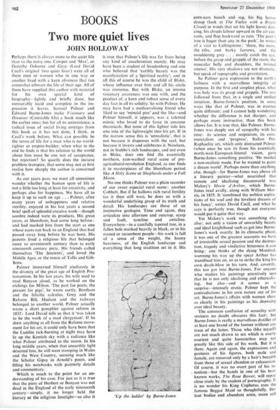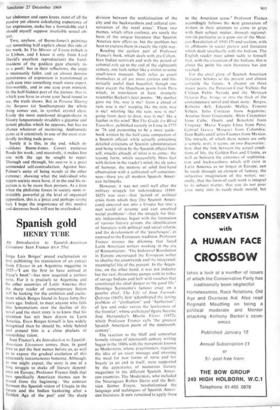BOOKS Two more quiet lives
JOHN HOLLOWAY
Perhaps there is always more to the quiet life than to the noisy one. Cowper and 'Max', or Dorothy Osborne and Gray (Lord David Cecil's original 'two quiet lives') were all of them men or women who in one way or another lived with a keen aliveness that ran somewhat athwart the life of their age. All of them have supplied this author with material for his own special kind of biography—lightly and briefly done, but memorably lucid and complete in the im- pression it leaves. Samuel Palmer and Edward Burne-Jones make Visionary and Dreamer (Constable 63s) a book much like the earlier ones; but for all its uninsistence, a radical issue of social living emerges from this book as it has not done, I think, in Cecil's work before. What can possibly be the terms of life for a man who is no world- righter or empire-builder, when what in the end he finds is that his relation to the world about him must be one not of acceptance, but rejection? So quietly does the incisive problem transpire, that some may not at first realise how sharply the author is concerned with it.
As our years pass, we must all sometimes wonder whether the human span of life is not a little too long at least for creativity, and perhaps also for happiness. We have all to keep it up to such an age . . . Palmer, after many years of unhappiness and relative sterility, enjoyed in his last years a second brief spell of splendid creative work—though sombre indeed were its products. His great years, at Shoreham, had come long before: and had marked him from the start as one whose roots ran back to an England that had passed away long before he was born. His parents lived a religious life that belonged more to seventeenth century than to early nineteenth century piety. His friends called themselves 'The Ancients', and loved the Middle Ages, or the music of Tanis and Gib- bons.
Palmer immersed himself studiously in the divinity of the great age of English Pro- testantism. In his last years, his wife used to read Bunyan aloud, as he worked on the etchings for Milton. 'The past for poets, the present for pigs', he wrote curtly. Bentham and the felicific calculus, Grey and the Reform Bill, Hudson and the railways belonged to another world. Palmer actually wrote a short pamphlet against reform in 1832: Lord David tells us that it 'was taken to be the work of a mad clergyman'. If he drew anything at all from the Reform move- ment for his art, it could only have been that the Luddite rick-burning at night may have lit up the Kentish sky with a radiance like what Palmer attributed to the moon. In his long middle years, when that unearthly light deserted him, he still went tramping in Wales and the West Country, seeming much like the Scholar Gipsy in Arnold's poem, and filling his notebooks with painterly details and commentary.
Which is much to the point for an un- derstanding of his case. For just as it is true that the piety of Herbert or Bunyan was not dead in the England of the early nineteenth century—simply, it no longer held the literary or the religious limelight—so also it
is true that Palmer's life was far from being any kind of anachronism merely. He may have been a student of Swedenborg and one who believed that 'earthly beauty was the manifestation of a Spiritual reality'; and in all this of course he was the child of Blake, whose influence over him and all his circle was immense. But with Blake, an intense visionary awareness was one with, and the product of, a keen and robust sense of every day fact in all its solidity. So with Palmer. He may have had a mediaevalising friend who liked to say 'minced pies' and the like—and Palmer himself, it appears, was a talented mimic who loved to do farce in amateur theatricals. But none of this lighter side lets one iota of the lightweight into his art. If in the narrow sense this is 'unrealistic', that is not because it dispenses with the real, but because it invests and celebrates it. Nowhere, not in Stubbs's rich landscapes, and not even in Blake, does one find the essentially northern, rain-washed rural scene of pre- agricultural-revolution England, as one finds it in masterpieces of the Shoreham period like A Hilly Scene or Shepherds under a Full Moon.
No one thinks Palmer was a plain recorder of our sweet especial rural scene: another Cobbett. But if he hallows rich rural fertility (as it then still was), he does so with a wonderful underlying grasp of its truth and detail. His landscapes are those of an instinctive geologist. Time and again, they articulate into alluvium and outcrop, scarp and fault, syncline and anticline. Everywhere—in a carefully tapered tree, in a fallen bole marked heavily in black, or in his rooted or recumbent people—his work is full of a sense of the weight, the loamy heaviness, of the English landscape and everything that long tradition set in it. His
'Up the ladder' by Burne-Jones
corn-ears bunch and sag, his big leaves droop (look at The Valley with a Bright Cloud) in winds that set his light leaves dan- cing, his clouds labour upward in the air cur- rents, and flop backward as rain. 'The poet's tree is huger than any in the park', he writes of a visit to Lullingstone: 'there, the moss, the rifts, and barky farrows, and the mouldering grey . . . mostly catch the eye, before the grasp and grapple of the roots, the muscular belly and shoulders, the twisted sinews'. His very shadows are not dramatic, butspeak of topography and gravitation.
So Palmer gave expression to the earth's holiness with a marvellous integrity of purpose. In the first and simplest place, what was holy was its grasp and grapple. The rest followed from that, in a single and unified intuition. Burne-Jones's position, in some ways like that of Palmer, was in essence quite different; and I cannot help wondering whether the difference is not sharper, and perhaps more instructive, than this book allows for. It is true that, like Palmer, Burne- Jones was deeply out of sympathy with his time: its science and scepticism, its com- mercialism and 'progress'. Italian Pre- Raphaelite art, which only distracted Palmer (when once he saw it) from his essentially north-west-European-littoral vision, gave Burne-Jones something positive. 'He needed a non-realistic mode. For he wanted to paint a dream world'. Perhaps more than anything else, though—for Burne-Jones was above all a literary painter—what nourished that remote and idealising dreamworld was Malory's Mode d'Arthur, which Burne- Jones read avidly, along with William Mor- ris, in 1855. It 'combined the noblest aspira- tions of his soul and the loveliest dreams of his fancy', writes David Cecil, and what he says is perfectly true, though not everyone would put it quite that way.
Yet Malory's work was something else also: not only a vision of unworldly beauty and ideal knighthood such as got into Burne- Jones's work overtly. in its climactic phase, it was one of the greatest accounts we have of irresistible sexual passion and the destruc- tion, tragedy and vindictive bitterness it can bring: one thinks of the dying Mordred, worming his way up the spear Arthur has transfixed him on, so as to strike the king his own death-blow in his turn. And, covertly, this too got into Burne-Jones. For anyone who studies his paintings attentively sees that he is not only idealising and etherealis- ing, but also—and it comes as a surprise—intensely erotic. Palmer kept the contradictions in his own nature out of his art. Burne-Jones's affairs with women show as clearly in his paintings as his drowsing over ideal beauty.
The common confusion of sexuality with sexiness no doubt obscures this fact: but Burne-Jones is really a marvellous distiller of at least one brand of the former without any trace of the latter. Those who (like myself) are not much drawn to sex which is overly esurient and quite humourless may not greatly like this side of his work. But it is there. Again and again, the expressions and postures of his figures, both male and female, are removed only by a hair's breadth from those of sexual abandon or exhaustion. Of course, it was no overt part of his in- tention—but the hands in one of his best- known works, The Rose Bower, will repay close study by the student of pornography. It is no wonder his King Cophetua eyes the famous Beggai Maid so thoughtfully. Her taut bodice and abundant arms, more still
her abdomen and open knees, most of all the passive yet almost calculating expectancy of her expression, make her a formidable and I should myself suppose insatiable sexual ob- ject.
Two, anyhow, of Burne-Jones's paintings say something half explicit about this side of his work. In The Mirror of Venus (which is in Lisbon, and I know it only from Lord David's excellent reproduction) the hand- maidens of the goddess gaze chastely in- to a pool: but in their reflections, the angle is necessarily fuller, and an almost demure pensiveness of expression is transformed in each case into something much more expert, this-worldly, and in one case even minxish. In the half-hidden part of the picture, that is, which you have to crane your head round to see, the truth shows. But in Perseus Slaying the Serpent (at Southampton) the whole thing comes out, in symbol, crystal clear. Easily the most outclassed dragon-slayer in history languorously straddles a gigantic and potent phallus which he opposes, but has no chance whatever of mastering. Andromeda gazes at it attentively in one of the most stan- dardly inviting nude poses.
Surely it is this, in the end, which in- validates Burne-Jones. Covert eroticism floods his work; and massively, it makes him one with the age he sought to reject. Through and through, his oeuvre is a great unintended self-contradiction. Against him. Palmer's unity of being stands at the other extreme: showing what the individual who rejects society must have, if in the end his re- jection is to be more than posture. At a time when the philistine forces in society seem ir- resistibly powerful at the level of organised opposition, this is a'treat and perhaps saving fact. I hope the importance of this modest and decorous book will not be overlooked.















































 Previous page
Previous page